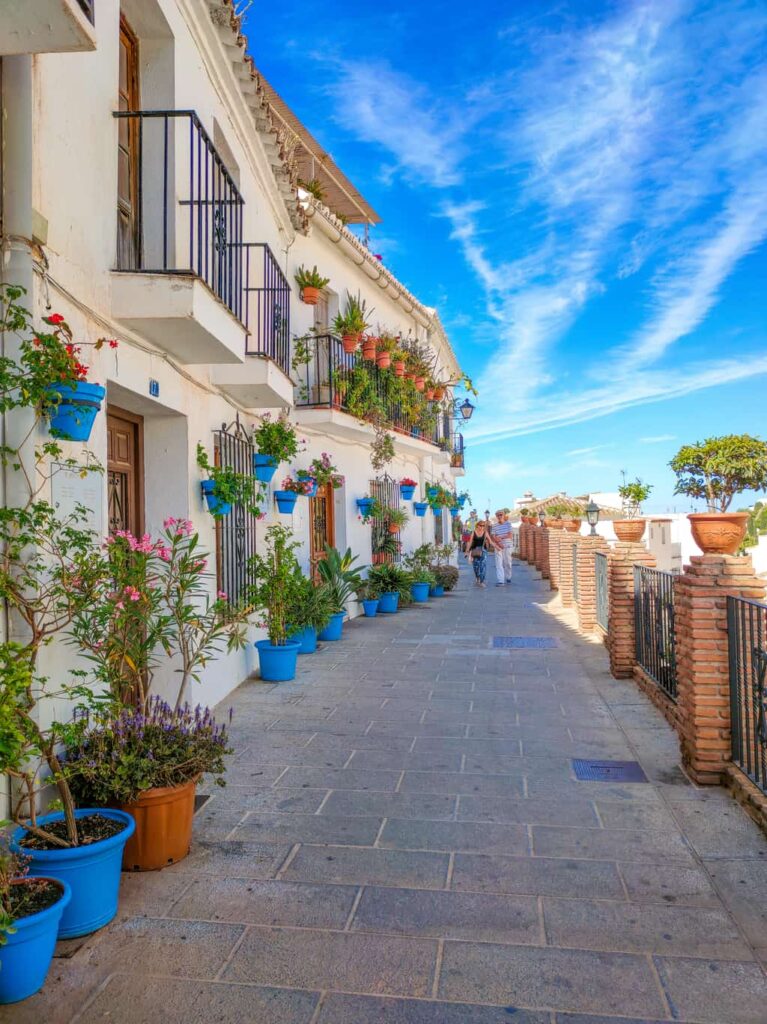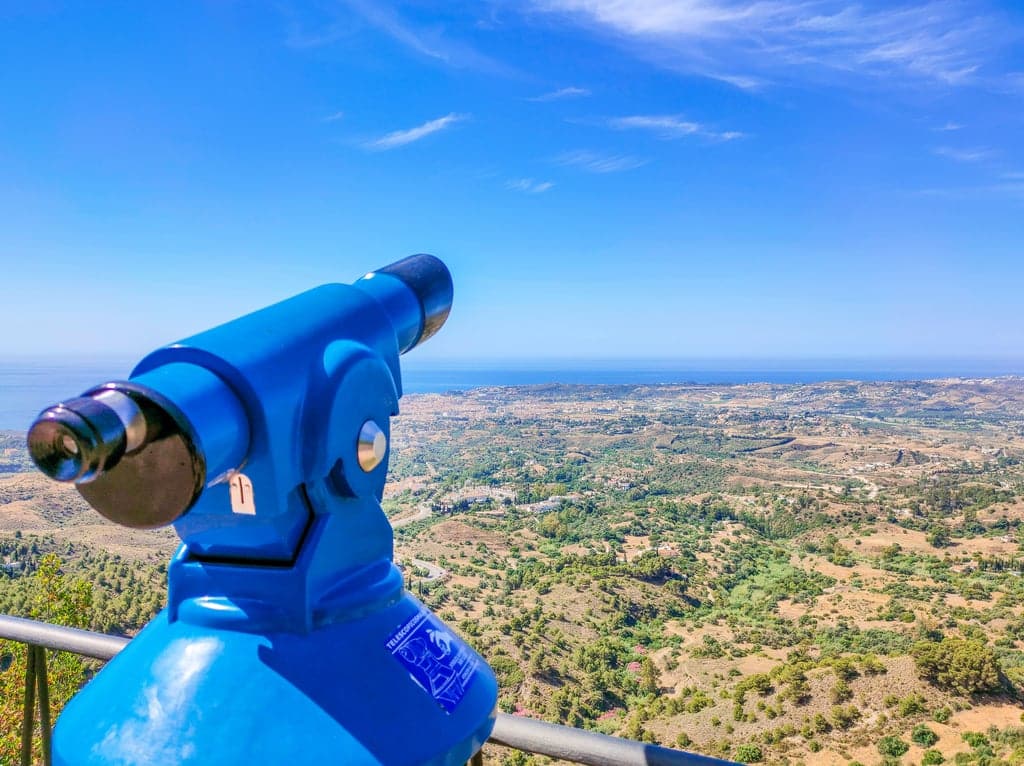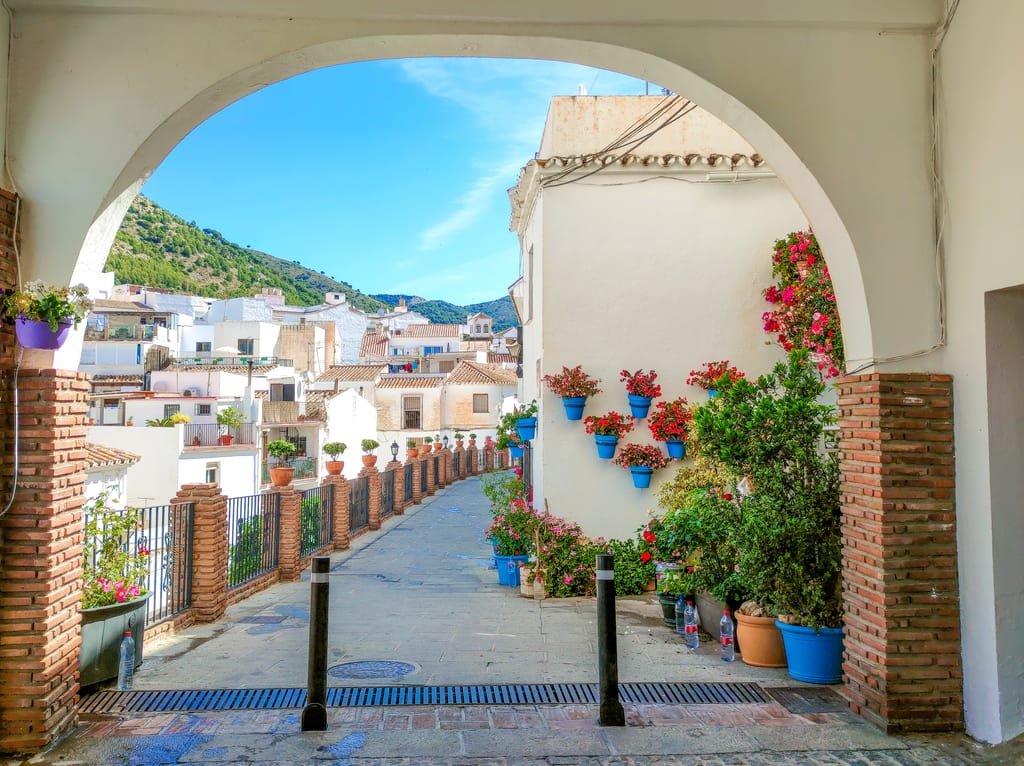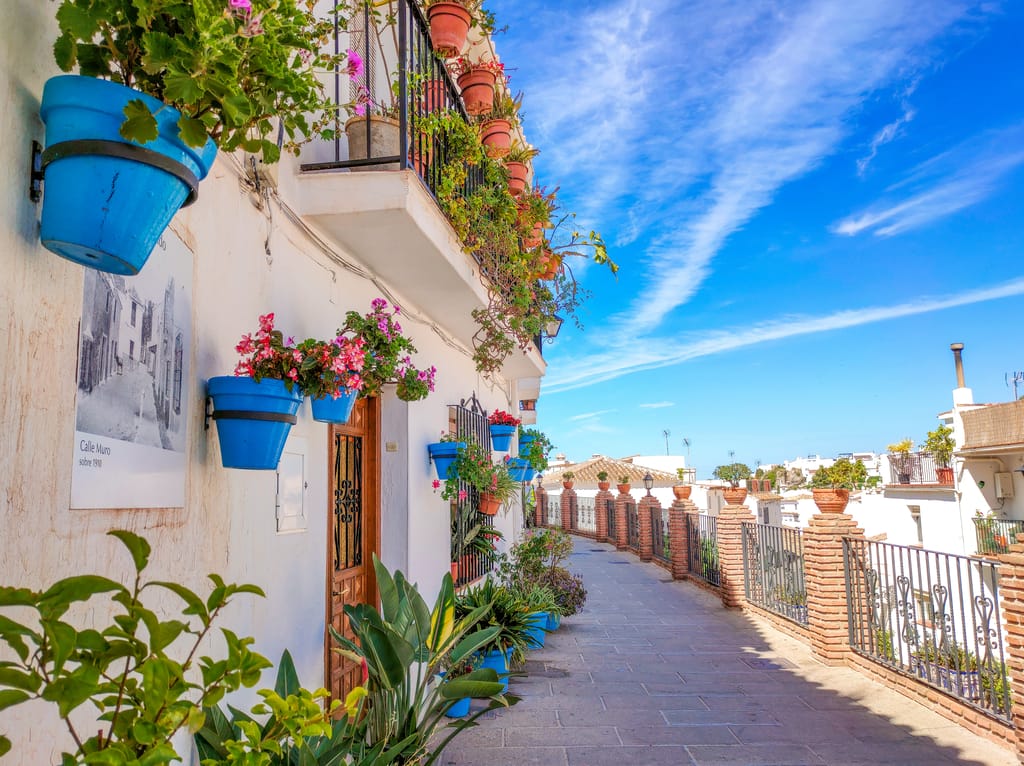Mijas is famous for being one of Spain’s whitewashed villages. Breathtaking views, quaint streets lined up with white houses with flower pots hanging on the walls, intriguing legends, and the unbeatable Andalusian charm have attracted tourists to this little hilltop village since the 1960s. Today, Mijas is a popular day-trip destination in Costa del Sol. Read further to find out what the best things to do in Mijas are, and also what you should avoid doing as a tourist.
Contents
- Is Mijas worth visiting?
- What’s the difference between Mijas Pueblo and Mijas Costa?
- Why is Mijas so famous?
- How to visit Mijas Pueblo
- Best things to do in Mijas Pueblo
- 1. Chapel of the Virgin of the Rock
- 2. El Compás viewpoint
- 3. The Old Flour Mill
- 4. Carromato de Mijas – Miniature Museum
- 5. Plaza de la Constitución
- 6. The Fortress of Mijas
- 7. La Muralla and the Botanical Gardens
- 8. Mijas Parish Church
- 9. San Sebastián Chapel
- 10. San Sebastián Street
- 11. Ethnographic Museum
- 12. Contemporary Art Centre (CAC)
- 13. De la Sierra Viewpoint
- What not to do in Mijas
DISCLOSURE: This post contains affiliate links. If you make a purchase via one of those links, I will earn a commission at no extra cost for you.
I have visited Mijas on a day trip from Marbella (Costa del Sol) when attending the TBEX blog conference there. The trip to Mijas, including the guided tour of the village, were provided by the Andalusian Board of Tourism. The entry to museums were optional and I have paid for them myself. The opinions in this post are mine and do not reflect the policy of my hosts.

Is Mijas worth visiting?
I have to admit that I was quite prejudiced about Mijas. On one hand I didn’t feel like visiting a place which main attraction is riding a donkey, on the other hand I was tempted to see what’s behind the hype of those white villages in Spain. The thing about being prejudiced is that you create an image of place where you focus only on the negatives without knowing what it is like from experience.

When I arrived in Mijas, I was blown away by the stunning views of the sea, the coast, and the mountains. Mijas was blinding with all those colors bathing in sunshine popping up against the white of the houses. And those narrow streets with colorful pots with blooming plants were more than cute.
So, yes, Mijas is absolutely worth visiting! I’ve learned my lesson: don’t judge about a place without having visited it.
What’s the difference between Mijas Pueblo and Mijas Costa?
Most of the tourists visiting Mijas on a day trip don’t realize there’s more than one place called Mijas. Actually, the municipality is called Mijas. It consists of Mijas Pueblo (the village of Mijas) – the hilltop village with whitewashed houses, Mijas Costa, the coastal area of Mijas, comprising of La Cala de Mijas and the villages Calahonda and Riviera, and Las Lagunas – a suburban and commercial area which is integrated partially in Fuengirola.

La Cala de Mijas (Mijas Bay) is located between Fuengirola and Marbella and is a resort town. Mijas Pueblo is located some 20 km north-east of La Cala de Mijas, at the foot of the Sierra de Mijas.
Why is Mijas so famous?
Mijas is one of the Andalusian whitewashed towns – pueblos blancos. This is a series of small hilltop towns and large villages, characterized by whitewashed houses with mostly red tiled roofs, and narrow alleyways, full of charm.
In Andalusia houses were whitewashed with slaked line (cal) not only to protect the inhabitants from the scorching sun in the summer, but also from infectious diseases like the plague.

Today, whitewashed towns, or white villages, are attracting thousands of tourists in search of authenticity in Andalusia
How to visit Mijas Pueblo
Whether you are vacationing on Costa del Sol, spending a long weekend in Málaga, or road-tripping in Andalusia, Mijas will be the perfect day trip or stop on your Spanish itinerary. If you are travelling by car, there are a couple of parking areas just outside the old town of Mijas Pueblo. So you can leave your car there and explore Mijas on foot.

If you are staying in Málaga, there’s a direct bus line from Málaga to Mijas Pueblo. The trip takes about 1 hr 20 min, and there are buses 4 times a day (bus line M-112), departing from the bus station of Málaga (Málaga Estación Autobuses), serviced by Avanza. For more information, check the website of Avanza.
Read more: How to spend one perfect day Málaga
Another option will be to take an organized day trip to Mijas. There are different tours offered from Málaga and other places on Costa del Sol:
- Mijas, Marbella and Puerto Banús Tour from Costa del Sol
- Mijas, Marbella and Puerto Banús from Málaga
You can also check on Expedia, Viator, or GetYourGuide for more trip ideas to Mijas.

Best things to do in Mijas Pueblo
On the map below you can find all things to do in Mijas. You can save the map on Google YourPlaces and use it even off-line.
1. Chapel of the Virgin of the Rock
The legend has it that in 1586 a white dove appeared before two children who were herding their flock of sheep and guided them to a place where Virgin Mary appeared. The Virgin Mary asked the children to tell everybody in the village about her so that they come and free her from the tower in the old castle where she was hiding for more than 500 years.

Almost a century later a Carmelite monk carved the chapel in the rocks and they placed the image of Virgin Mary inside. This was the beginning of the Chapel of the Virgin Mary of the Rock (la Ermita de la Virgen de la Peña). Virgin Mary of the Rock is also the patron saint of Mijas, celebrated on 2 June.

I found different stories about as to who carved the chapel and when. The above story I heard from our guide when I was in Mijas. I also found it here on this site. However, according to some other sources the sanctuary was carved in 1548 by Mercederian friars.

2. El Compás viewpoint
In front of the chapel there is lovely garden and next to it is one of the two panoramic viewing point in Mijas: Mirador del Compás. From there you have an amazing view over Costa del Sol and the sea. Just take a sit on one of the benches, relax and enjoy the scenery.

3. The Old Flour Mill
The Old Flour Mill (Antiguo Molino de Harina) is a reconstruction of a traditional flour watermill, the way they used to be in the past. At one point, there were 22 flour mills in Mijas and none of them has survived till the present day. When I visited Mijas, the flour mill was closed, so I could see it only from outside.

4. Carromato de Mijas – Miniature Museum
Carromato de Mijas (the Wagon of Mijas) is quite a peculiar museum. It exhibits miniature works from over 50 countries and was established in 1972 by Juan Elegido Millán, known as Professor Max. You can see there a naval battle on the head of a pin, Leonardo da Vinci’s Last Supper on a grain of rice, or a ballerina carved on a toothpick. So, no wonder this museum is housed in a wagon.
Address: Avenida del Compás, Mijas
Admission fee: adults: 3 EUR; kids (6-14 yoa): 1,50 EUR
Opening times: in the summer, daily from 10:00 till 20:00; winter, from 10:00 till 18:00
Website: www.carromatodemijas.org
5. Plaza de la Constitución
Constitution Square (Plaza de la Constitución) is the heart of Mijas. In the middle of the square there’s a lovely fountain that’s connected to a dark part of the history of Mijas. On 2 November 1884, after a heavy rainfall in the mountains above Mijas, a flooding occurred. The flood and landslide destroyed lots of houses and cost the life of a number of people and of numerous animals.

To commemorate this tragic event in the history of Mijas, a fountain was made with the stones carried to the village with the flooding. The benches around the square are also made with those stones.
6. The Fortress of Mijas
Once Mijas was a fortified city. The Fortress was built in the Middle Ages on the ruins of old Phoenician fortifications. Today, there isn’t much left of the castle and fortress of Mijas, only the ruins of a fortification wall (La Muralla) and a watchtower, which were reconstructed the last years.

After the Catholic Monarchs conquered Mijas in1487, they ordered the destroying of the fortress and enslaving of its inhabitants.
7. La Muralla and the Botanical Gardens
The Fortress Wall, known as La Muralla, once part of the Medieval fortifications of Mijas, is today a lovely botanical garden, that offers stunning vistas of Costa del Sol and the Mediterranean Sea. It’s also one of Mijas’ most famous attractions. So, when in Mijas, do not miss to walk along Paseo de la Muralla and enjoy the views all the way.

At the Botanical Garden you can spot 140 native and exotic species and all of them are marked with information boards. You can also download here a map of the so-called botanical route, together with a description of every plant that you can see in the gardens.
8. Mijas Parish Church
The Parish Church of Mijas or the Church of the Immaculate Conception (La Iglesia de la Inmaculada Concepción) was built on the place of the old mosque as it usually happened in Southern Spain after the Catholic Monarchs took over Mijas.

The current church was finished in 1631. A fun fact is that an old tower most probably built in the 16th century was converted into the church bell tower. The tower is know as Torre de la Vela.

9. San Sebastián Chapel
This lovely chapel, built at the end of the 17th century, blends perfectly with the surrounding buildings. This was quite the trend of the time when hermitages for popular devotion would just pop up in residential areas integrating perfectly among the rest of the buildings on the street. The clock on the façade of the San Sebastián Chapel (Ermita de San Sebastián) was put in 1902.
The chapel is located on Plaza de la Libertad – a small square in the heart of Mijas.

10. San Sebastián Street
Without a doubt this is the most famous street in Mijas, and the most photographed one, too. Before visiting Mijas, any mentioning of a Spanish white village would evoke this image of a narrow street, going up with flower pots overhung with red geraniums, hanging on the walls of the houses. Well, that turned to be the San Sebastián Street (Calle San Sebastián)!

I was quite prejudiced that I wouldn’t like it, as I’ve seen it so often on Instagram. So, I was standing there, looking at a lifestyle instagrammer taking perfect shots of herself and the clothes she wore with the lovely street as a backdrop, and I was thinking to myself, this is exactly why I’m not liking it…
Later in the day, I returned to San Sebastián but I approached the street from the other end, not from the square by the church, and I was quite surprised. The street had it’s own life – people getting in and out of the houses, carrying groceries, or sitting in front of the shops. It was just a lively street with flowers in pots hanging on the walls.

11. Ethnographic Museum
This is my favorite attraction in Mijas! The Ethnographic Museum is quite often overlooked by tourists, but it’s absolutely worth visiting. Located across the street from the San Sebastián Chapel on Plaza de la Libertad, one would just pass by without noticing it. The Ethnographic Museum of Mijas (Museo Histórico Etnológico de Mijas) is housed in the old town hall. It tells the story of the village and the bygone times with everyday objects and ethnographic displays.

You can see there how oil is made, or honey, or wine; how people lived and how people worked in Mijas and the surroundings. Various local crafts and trades are exhibited with an eye for the details, and feels as if you are taking glimpses of someone’s life and home.
Address: Plaza de la Libertad, Mijas
Admission fee: 1 EUR
Opening times: Monday-Friday, from 10:00 till 18:00; Saturday-Sunday, from 10:00 to 14:00 and from 15:00 to 18:00.
12. Contemporary Art Centre (CAC)
The Contemporary Art Centre (Centro de Arte Contemporáneo) in Mijas is fairly new. It was opened in 2013 and since then turned into one of the must-visit places in Mijas. Surprisingly, for an art museum of a small village, the CAC has an amazing collection of works of Picasso and Dalí, shown at the two permanent exhibitions in the museum. There are also temporary exhibitions curating local and international modern art.
Address: C/ Málaga, 28. Mijas
Admission fee: adults – 3 EUR, kids under 5 yoa – free of charge
Opening times: daily, from 10:30 till 14:00
Website: cacmijas.info (only in Spanish)
13. De la Sierra Viewpoint
They say that on a clear day you can see Gibraltar and even the coast of Morocco from this viewpoint. It’s located just above the village, where the mountains (La Sierra) begin. It was previously known as Mirador de la Sierra (De la Sierra Viewpoint) or the viewpoint at the ring road of Mijas. In 2021 the name was changed to Juan Antonio Gómez Alarcón Viewpoint, dedicating it to a mountaineer who disappeared without any reason in 2010 and who was never found.
What not to do in Mijas
1. Donkey Taxi
Although the donkey taxi (burro taxi) is one of the attractions that made Mijas famous, I think this attraction should remain in the past. Historically, donkeys have been used for work, to pull a cart or to carry packs, as drought animals. And of course you can ride a donkey, but there’s quite a lot to be considered.

A grown-up, physically fit donkey can carry about 20%-30% of its weight, which means that most of the adults will be too heavy for a donkey to carry them. Let’s say, an average donkey weighs about 200 kg, this means that the donkey can carry about 40-60 kg max, including the saddle and the rigging.
This is not the only reason, why you should not take the burro taxi. In a modern world, where we are concerned about animal welfare and climate change, riding a donkey as a tourist attraction is simply inappropriate and an anachronism.
2. Plaza de Toros (The Bullring)
Bullfighting is another attraction that should remain in the past. Although it’s considered a cultural heritage in Spain and still is among the most popular events in certain regions, bullfighting belongs to the past. It has played a major role in the history of Spain, and we can’t imagine Spain without the corrida, but bullfighting should remain in the history books and the museums.

It should be mentioned that the bullring in Mijas is not used as such anymore. The bullring in Mijas was built in 1900. Particularly interesting is the oval form, which is quite unusual for this type of buildings.
You might be also interested in the following guides if you are preparing your trip to Spain:




